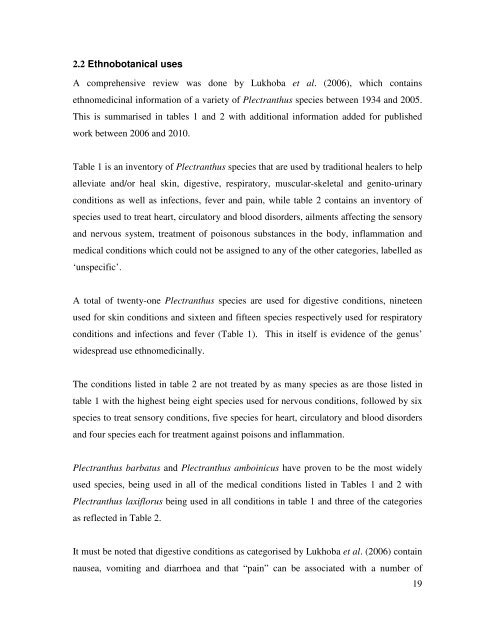university of kwazulu-natal faculty of science and agriculture school ...
university of kwazulu-natal faculty of science and agriculture school ...
university of kwazulu-natal faculty of science and agriculture school ...
You also want an ePaper? Increase the reach of your titles
YUMPU automatically turns print PDFs into web optimized ePapers that Google loves.
2.2 Ethnobotanical uses<br />
A comprehensive review was done by Lukhoba et al. (2006), which contains<br />
ethnomedicinal information <strong>of</strong> a variety <strong>of</strong> Plectranthus species between 1934 <strong>and</strong> 2005.<br />
This is summarised in tables 1 <strong>and</strong> 2 with additional information added for published<br />
work between 2006 <strong>and</strong> 2010.<br />
Table 1 is an inventory <strong>of</strong> Plectranthus species that are used by traditional healers to help<br />
alleviate <strong>and</strong>/or heal skin, digestive, respiratory, muscular-skeletal <strong>and</strong> genito-urinary<br />
conditions as well as infections, fever <strong>and</strong> pain, while table 2 contains an inventory <strong>of</strong><br />
species used to treat heart, circulatory <strong>and</strong> blood disorders, ailments affecting the sensory<br />
<strong>and</strong> nervous system, treatment <strong>of</strong> poisonous substances in the body, inflammation <strong>and</strong><br />
medical conditions which could not be assigned to any <strong>of</strong> the other categories, labelled as<br />
‘unspecific’.<br />
A total <strong>of</strong> twenty-one Plectranthus species are used for digestive conditions, nineteen<br />
used for skin conditions <strong>and</strong> sixteen <strong>and</strong> fifteen species respectively used for respiratory<br />
conditions <strong>and</strong> infections <strong>and</strong> fever (Table 1). This in itself is evidence <strong>of</strong> the genus’<br />
widespread use ethnomedicinally.<br />
The conditions listed in table 2 are not treated by as many species as are those listed in<br />
table 1 with the highest being eight species used for nervous conditions, followed by six<br />
species to treat sensory conditions, five species for heart, circulatory <strong>and</strong> blood disorders<br />
<strong>and</strong> four species each for treatment against poisons <strong>and</strong> inflammation.<br />
Plectranthus barbatus <strong>and</strong> Plectranthus amboinicus have proven to be the most widely<br />
used species, being used in all <strong>of</strong> the medical conditions listed in Tables 1 <strong>and</strong> 2 with<br />
Plectranthus laxiflorus being used in all conditions in table 1 <strong>and</strong> three <strong>of</strong> the categories<br />
as reflected in Table 2.<br />
It must be noted that digestive conditions as categorised by Lukhoba et al. (2006) contain<br />
nausea, vomiting <strong>and</strong> diarrhoea <strong>and</strong> that “pain” can be associated with a number <strong>of</strong><br />
19

















